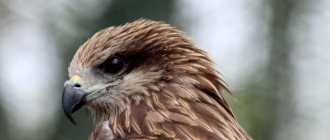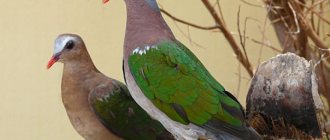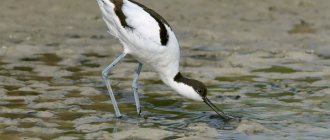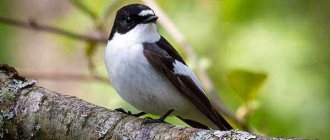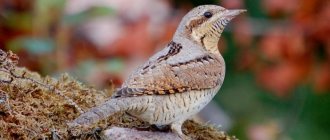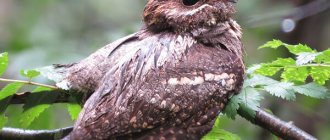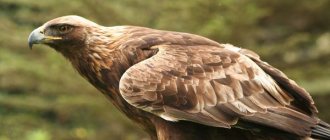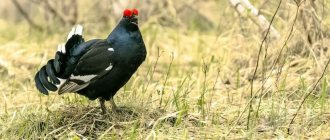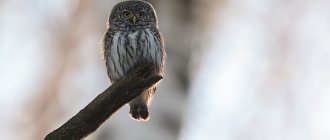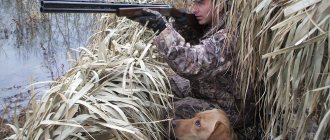Appearance of a great curlew
The body weight of the large curlew ranges from 0.6 to 1 kg, body length 50 – 60 cm. The wingspan of the bird is 80 – 100 cm.
Great Curlew (Numenius arquata).
This species is not only the most common among all species of the curlew genus in Europe, but also the largest representative of the order Charadriiformes. A characteristic feature of this bird’s appearance is its long, downward-curved beak. In this species, the male is much smaller than the female. The female's beak is longer and more curved. Apart from these features, there are no significant differences in appearance between males and females.
The plumage of the great curlew ranges in color from gray-brown to beige-brown. The color of the bird's body is not uniform; there are various inclusions and stripes on the body.
The curlew is the largest and most commonly encountered member of the Charadriiformes.
Nest
The curlew nest (you can see a photo of the bird in this article) is represented by a shallow hole, covered with grass or located openly. At the bottom there is a lining of dry leaves, fragments of branches, and other natural material. The clutch usually contains from 2 to 4 eggs. They are colored green, blue, olive or grayish. You can see spots of brown and brown color on them. Eggs vary in size, spots can have different intensity and thickness.
The clutch is incubated by two adults, alternating each other for 28 or 30 days. They are very careful. If they sense danger, they begin to circle around a predator or a person, while emitting alarming cries. They attack smaller opponents, such as other birds, and drive them out of the nesting area. At the 6th week of life, the birds begin to fly, after which flocks with grown chicks form.
Distribution and habitats of the great curlew
The main distribution area of this bird is Central and Northern Europe, as well as the British Isles. In Europe, the southern border of the range runs approximately along the 45th parallel. Curlews are also found throughout most of the Asian continent. Here their habitat extends to Kyrgyzstan in the south and to Manchuria and Lake Baikal in the east.
This species is mainly migratory. Only a few individuals live a sedentary life. For the winter, the great curlew migrates to the Mediterranean, the Atlantic coast and Africa.
Within the breeding range, the bird prefers to settle in wet, swampy landscapes. In winter, large curlews live inland on water meadows and fields, as well as in the wattles and on the coasts.
As a rule, males sing, using sounds to mark their possessions.
Lifestyle
The curlew bird is an adherent of a social lifestyle. Numerous flocks are not uncommon. Individuals fly to nesting sites in pairs, alone or as part of a flock. In central Russia, their nesting period begins in April, in the steppe regions - in March, in the northern regions - in May. Almost immediately after arrival, mating begins. The male rises up, as if on a ladder, emits a sonorous whistle and then glides over the ground. This movement is repeated several times.
Nesting occurs near water. Curlews live in pairs or flocks. Despite their peacefulness and social way of life, they are ready to guard the borders of the settlement to the last. They are characterized by nested conservatism. This means that individuals return to the same territories every year.
Lifestyle and diet of the great curlew
The bird leads a fairly social lifestyle. On migration, curlews form huge flocks. Using its long curved beak, the bird extracts worms, snails, mollusks and other living creatures in a layer of silt and sand.
Vision is not a very necessary element of a successful hunt for the curlew, since it searches for prey using the sensitive end of its beak. During wintering, curlews often hunt in shallow waters, catching young fish and shrimp. Also of particular interest to the birds are heaps of seaweed thrown ashore, in which curlews look for crabs. At nesting sites, the main prey are earthworms, insects and their larvae, small frogs and mollusks. In the summer, large curlews hunt for various beetles in fields and plantations.
In winter, large curlews live along the coasts, inland - in fields and water meadows.
Security
Bird conservationists are now alarmed that the curlew population is declining at a rapid rate. This is facilitated by the drainage of swamps, excess moisture in lowlands, the development of vast lands for the purpose of creating arable land, as well as the destruction of the natural habitat of birds for subsistence farming. All this leads to a decrease in the number of territories suitable for nesting.
As mentioned earlier, adult birds return to the same place. And if sexually mature individuals are able to protect themselves or at least hide from the enemy, then for chicks walking through arable land can be dangerous. Mechanical cultivation of the fields, as a rule, begins before the chicks fledge. They try to hide in the thickets of grass, since they cannot fly away from the dangerous territory. As a result, they die because they have nowhere to hide.
There is a solution to this problem. It is necessary to mow the grass in parallel rows, leaving strips of tall grass between them. They would make an ideal hiding place for curlew chicks.
Reproduction of the Great Curlew
The first individuals begin to arrive from wintering grounds in late March - early April. Almost immediately after arriving at the nesting sites, the birds occupy nesting areas. The Great Curlew is a monogamous bird. Curlew nests in pairs or small groups. Before mating, the male attracts the female using current flight.
The Great Curlew is a migratory bird.
The nest of the great curlew is a hole in a small grass hummock, ground or mound among sparse vegetation. The bedding in the nest is small twigs, stems of horsetail and cotton grass, dry grass and feathers. Egg laying begins in late April - early May. One clutch contains on average 4 eggs.
The shell is colored greenish and covered with many brown specks. The incubation period lasts 27 – 29 days. The female and male take part equally in incubating the clutch. The nest is actively protected from ill-wishers.
Curlews use their beaks as tweezers to remove snails or shells from their hard shells.
The birds drive away the invading enemy with loud cries. The chicks are born covered in down and fairly well developed. Soon enough, they leave the nest and go to feed under the leadership of the “father of the family.”
Until young birds learn to fly, they spend most of their time in dense thickets, which give them shelter from ill-wishers.
If you find an error, please select a piece of text and press Ctrl+Enter.
Coloring
The bird that will be discussed in this article has a beautiful coloration. The Great Curlew is a rather cute creature with brownish-gray feathers that retain their color throughout the year. They may have large black-brown spots, as well as ocher or light edges. The top of the head, as well as the front of the back, is slightly darker than the neck. On the back of the back there are pure white feathers with rich brown spots.
There is a light stripe above the eyes. The lower body is colored ocher. There are longitudinal stripes on the chest, neck and sides. In some individuals, a triangle-shaped pattern can be observed on the side of the abdomen. The chin and lower tail coverts are completely white. The tail is mottled. The tip of the beak is black, the base is brownish, the mandible has a reddish tint. The legs are dark leaden or grayish. Since the lower wing feathers are white, the bird appears light in color when flying.
Young curlew birds are more buffy and also have a very short beak compared to adults. The chicks are dirty white or yellow, with dark stripes on their backs. On the lower part of the body the streaks are narrow and longitudinal.
Spreading
Great curlews belong to migratory birds. They breed their offspring in regions of Asia and Europe with a temperate climate, and fly to warm countries for the winter. The main wintering areas include the African coast, the Mediterranean and the southern regions of Asia.
Representatives of this species choose peat soils and wet meadows for nesting. Sometimes they breed their offspring in foothill areas and on heather-covered plains. Birds give particular preference to the mouths of large rivers and fields covered with grain crops.
The population of European curlews is gradually disappearing. Almost everywhere their traditional nesting sites are becoming unsuitable for breeding, which is the main reason for the decline in population size.
Curlews are often forced to nest on arable land. Chicks bred in such conditions are exposed to unnecessary risks. The young do not have time to learn to fly before the harvest begins and die during harvesting work. To protect the young, during haymaking, many farmers leave uncut areas of grass where the birds could hide.
S.T. Aksakov. “Notes of a rifle hunter of the Orenburg province”
Steppe waders in the steppes are the same as marsh waders in swamps: they meet a person, a dog, even any animal approaching their nests or children just as far away, they also first fly close to the hunter, hover over him and sit in a circle, trying to ward off it in the opposite direction, but they do all this with less ardor and more caution.
After several shots, the steppe waders move away and become guards. However, in the steppes, which have not heard a rifle shot, the first attack of curlews, especially on a traveling hunter with a dog, can be very bold. In my youth, I happened to travel a lot along the steppe roads of the Orenburg and Simbirsk provinces, and whole flocks of steppe waders, swooping in from all sides, used to pursue me for dozens of miles, being replaced by newly arriving, fresh curlews, as I moved away from the nests of some and approached others. . The whole air was filled with their sonorous, flooded trills: some hovered over the horses; others sank to the ground near the road and ran with incredible agility; still others sat along the milestones. Here you could shoot as many curlews as you wanted, because new, unafraid waders were constantly being encountered. Many times I found myself in a difficult situation for an ardent hunter: driving through some need, sometimes very urgently, having filled a whole bunch of curlews, not finding a place to put them, and not knowing what to do with them later, I constantly made a promise to myself : don’t stop, don’t get out of the carriage, don’t shoot...
But suddenly a new flock swooped in, larger and bolder than the previous one, and again the curlews fell from my well-aimed shots. Curlews of the small genus show much more courage and ardor towards children; medium ones are more careful, and large ones, even the first time, sometimes do not fly too close to a person, unless somehow by accident: they will now move away to a safe distance and begin to fly around, emitting their hoarse, seemingly creaking, short trills. Here a young, ardent hunter can sow a lot of shot across the green steppe without killing a single large curlew, especially if he starts using not the largest types of shot. True, the larger the shot, the wider it spreads and the less often it flies, and the more difficult it is to hit the target, but the fact is that at a long distance, that is, sixty or seventy steps, you cannot kill a large curlew even with shot number 3, for the steppe sandpiper is much stronger to the gun than marsh and other waders. It's amazing to what extent the eyesight is deceived! Will the hunter take a closer look at the circles that the bird makes near him, and they will begin to seem smaller to him, or during turns, sometimes sharp, around which the hunter himself turns, will it seem to him that the sandpiper is flying straight at him!.. I don’t know, just this. I myself was often deceived, and many mistakes were its consequence.
Sometimes, having killed a curlew and measured the distance, which seemed ordinary, I found that it was far beyond seventy paces, and I would not even shoot at this measure. In such desperate circumstances, seeing that duck shot did not “take away”, as hunters say, I used goose shot and, although occasionally, I caught several huge steppe animals.
As soon as the young ones begin to fly, the old ones will begin to wander with them in separate broods across plowed fields, recent fallow lands, and generally in places where the ground is softer; then they unite into villages, broods of two and three, and finally they flock into large flocks, in which all three genera of curlews are sometimes mixed, and begin to visit swamps, overflows of large ponds and the flat shores of large lakes. They spend several hours there, around noon, and rest, lying on the fluff, even dozing. They most willingly wander through dirty, wet places trampled by herds.
Having staggered in this way for two weeks, curlews, despite the warm, sometimes even hot weather, disappear in mid-August, that is, uniting in even larger flocks, they move to the south. This happens at least in the Orenburg province.
The shooting of curlews is very different both in their prey ability and in the dignity of the prey: steppe waders in the spring, migratory, have not yet split into pairs or at least have not begun to build nests, are quite well-fed, tasty and, most importantly, rare. Of course, among various passing game you hear and see flocks of curlews flying by, but beyond the range it is impossible to shoot them. Then you will begin to meet them occasionally, also together with other game, along the dirty banks of ponds, spring puddles and flooded rivers, but it can be very difficult to approach them within a rifle shot: firstly, because they are guardhouses, and secondly, because other small game, constantly flying up from your approach, frightens and captivates the curlews with their example; sneaking up from behind something or even crawling is impossible because the places are almost always open and smooth.
In a word, the spring migratory steppe sandpiper is an expensive prey for a hunter. In the steppe, in their places of permanent residence, they are also quite watchful at first. Of course, they soon become quieter, but having already split into pairs, started making nests and losing weight at an incredible speed. Later, when the curlews sit on the eggs or hatch young, you can catch much more of them, and in places that are not shot, as I already said, it is not difficult to kill them in large numbers, but at this time, even more emaciated, dry and stale in taste, they will lose their value, especially the steppe inhabitants of the third, small, kind. All this shooting is carried out from the beginning of spring from the entrance to sessile and, most often, running curlews, and then - flight, when, at the first appearance of the hunter, waders from the nests begin to fly and hover around him.
When young curlews rise and begin to fly in broods across the fields, and then in flocks along the banks of ponds or lakes, shooting them again receives a high price, because they are difficult to find and even more difficult to approach them, for they are very watchful even after the first shot fly to other, distant places.
By the time they fly away, the old curlews have become so fat that the whole fluff is covered with lard, even the young ones are quite fat. This is the time when catching curlews is expensive and flattering; but, unfortunately, the production is insignificant and random; There is no actual hunting for curlews at this time. If you somehow accidentally stumble upon a large village of steppe waders while driving around the banks of a pond, lake or river reach, then it’s good if you manage to shoot at them once; it is necessary that the places be very spacious and free, and that the flock of curlews move to the other bank or another place after your shot, and not fly away completely. You can knock out several pieces from a flock with one or two shots only if the terrain allows you to sneak up on a roaming flock because of something, or if it runs into a hunter who had the opportunity to hide in a bush, in a rut, in a ravine, in the reeds or simply on the ground, but for this it is necessary that the hunter knows in advance when the curlews arrive and in what favorite place they land, so that he waits for them or sees at least from a distance a flying flock.
In my neighborhood, about twenty miles away, there was a pond to which curlews flew before their departure in the fall every day at noon; this arrival was repeated constantly every year at the end of July or at the beginning of August and lasted for two weeks. Fortunately, it was along that same bank, flat and open, on which the whole flock usually sat down, that stretched an old, half-rotten fence that had once surrounded the hemp, abandoned for more than ten years; the fence was always overgrown with tall grass, and I was able to hide in it cleverly. Around noon I sat down in my secret shelter and waited for the arrival of the curlews. A huge flock of steppe waders of all three breeds flew towards me smoothly and carefree; I heard not only the noise - the wind from their heavy flight; A dark cloud rushed over me, all made up of long wings, legs, necks and crooked noses...
The first time I was so taken aback that I missed the flock and shot in pursuit at one lagging sandpiper and wounded it in the wing. Subsequently, I was calmer and aimed either at the largest curlew, or at the place where the flock was denser, not letting it get too close to me or missing it; shooting at too close a distance means killing and often tearing apart only one sandpiper. Sometimes I allowed them to sit down and shot at the sitting ones, and I happened to knock out three or four curlews with one shot. The frightened flock, excited, flew away noisily, but, having made a circle and not seeing the presence of a person anywhere, returned back and often sank back to its original place solely because I did not leave my shelter and did not pick up the killed or shot curlews; the latter circumstance is very important, because a flock will almost always descend on a wounded bird. The second shot brought me new prey, and the curlews flew away completely until the next day. However, I never arrived two days in a row, but always a day or two later, and always found them before departure, which never happened later than August 17th.
The taste of curlew meat is as completely different as the hunt for them: upon arrival they are quite juicy and tasty, during hatching they are dry and stale, and on departure both young and especially old ones, drenched in fat, are excellent.
INTERESTING FACTS, INFORMATION…
- During the migration period, curlews unite in large flocks. They fly at night, then in the dark only their screams can be heard.
- The rhythm of life of birds living on the sea coast depends on the ebb and flow of tides, which are periodically repeated, and not on the change of day and night. During high tides, birds rest, and during low tides they look for food.
- The beak of the female curlew is 5 cm longer than the beak of the male, so partners can feed together on the same coastal site without competing with each other, since they search for food at different depths.
Behavior
In addition to the nesting period, curlews gather in flocks. The bird is busy hunting all day. She slowly moves around her territory and looks for food, sticking her beak into the soil every minute. The tip of the beak is densely supplied with nerve endings, which greatly facilitates the search for food.
Curlew's favorite delicacy is nimble crabs and small shrimps. Before eating the crab, the bird plucks off its paws and swallows the shrimp completely. In addition, its diet is supplemented with bivalves and worms. If the hunt takes place on land, then the usual lunch consists of earthworms, all kinds of insects, small snails and ripe berries.
Great curlews fly very well. Their flight often turns into gliding. Curving their wings upward in the air, they announce the surroundings with sounds reminiscent of playing a flute. Having noticed an uninvited guest, the bird warns its relatives with a series of short cries. In the evening twilight, birds gather in flocks and settle down for the night in some secluded place.
Links[edit]
General links[edit]
- Hayman, Peter; Marchant, John and Prather, Tony (1986): Shorebirds: An Identification Guide to the World's Shorebirds
. Houghton Mifflin, Boston. ISBN 0-395-60237-8 - Svensson, Lars; Zetterstrom, Dan; Mullarney, Killian and Grant, P.J. (1999): The Collins Guide to Birds
. Harper and Collins, London. ISBN 0-00-219728-6 - Corso, Andrea; Jansen, Justin; Kokay, Szabolcs (2014). Review of identification criteria and variability of the slender-billed curlew. British Birds 107: 339–370.
Identification[edit]
- Identification of the Slender-billed Curlew, John Marchant, British Birds
77: 135–140. - Studies of the Slender-billed Curlew, Richard Porter, British Birds
77: 581–586. - Habitat of Slender-billed Curlews in Morocco, Arnoud van den Berg, British Birds
83:1–7. - Slender-billed Curlew in Tunisia in February 1984, Eddie Weimengs and Klaas van Dijk, Dutch Birding
7: 67–68. - Slender-billed Curlews in Morocco in February 1979, Peter Ewins, Dutch Birding
11: 119–120. - Identification of the Slender-billed Curlew and its occurrence in Morocco during the winter of 1987/88, Arnoud van den Berg, Dutch Birding
10: 45–53. - Slender-billed Curlew in Sicily, March 1996, Andrea Corso, Dutch Birdwatching
18: 302. - Slender-billed curlew collected at Canis Vliet in September 1896, Günter De Smet, Dutch Poultry Science,
19: 230–232. - Identification of the Slender-billed Curlew, British Birds
Vol 56 No8 1963 - Kirwan, Guy; Porter, Richard; Scott, Derek (2015). Chronicle of extinction? A review of records of the slender-billed curlew in the Middle East. British Birds 108:669–682.
Special links[edit]
- BirdLife International (2012). » Numenius tenuirostris » . IUCN Red List of Threatened Species
.
2012
. Retrieved November 26, 2013.CS1 maint: ref=harv (link) URL of old form - Gretton, Adam; Yurlov, Alexander K. and Boer, Gerard S. (2002): Where does the Slender-billed Curlew nest and what is its future? British Birds 95
(7): 334–344 ISSN 0007-0335 Abstract in HTML format - Cleeves, Tim (2002): Slender-billed Curlew in Northumberland: a first in Britain and Ireland. British Birds 95
(6):272–299 (2002) ISSN 0007-0335 HTML abstract - BOU (2013). "Changes to the UK List". Retrieved December 5, 2013.
- Goriup, Paul; Baboianu, Grigore and Cernicco, Joseph (2007): The Danube Delta: Europe's remarkable wetlands British Birds 100
: 194–213 ISSN 0007-0335 - Zhmud, M. 2005: Slender-billed curlew: a promising discovery in the Danube Delta Weider Bull Research Group. 106
:51–54
Russian spring. Voices of the swamp. Russian spring The voices of god. Video (00:07:17)
For several million years, these voices have been heard in the swamp every spring. (prologue: owl in the forest; further: curlew, black grouse, cranes, lark, lapwing, golden plover, in episodes (silently): two ospreys on the nest)
For several million years, every spring, the bog space is filled with special sounds. Have you ever heard them? (Prologue: owl voice in the forest. Curlew, black grouses, cranes, lark, lapwing, golden plover. In the episodes (mute): two ospreys on the nest.)
WHERE DOES IT LIVE?
Just 60 years ago, the great curlew was considered a typical inhabitant of coastal swamps and lowlands. However, during this time, significant changes occurred: the area of the species’ natural habitats decreased so much that the birds were forced to nest in other places - in meadows and pastures. But the ability of this species to adapt to new conditions is not unlimited, especially since intensive human economic activity associated with the widespread use of artificial fertilizers and pesticides displaces the bird from these places. In spring and summer, curlews live in the interior of the continent, and in the fall they fly to their wintering grounds on the sea coast. Despite the fact that there is plenty of food off the coast of Central Europe during this period, large curlews fly to the southern coast and to North Africa.

